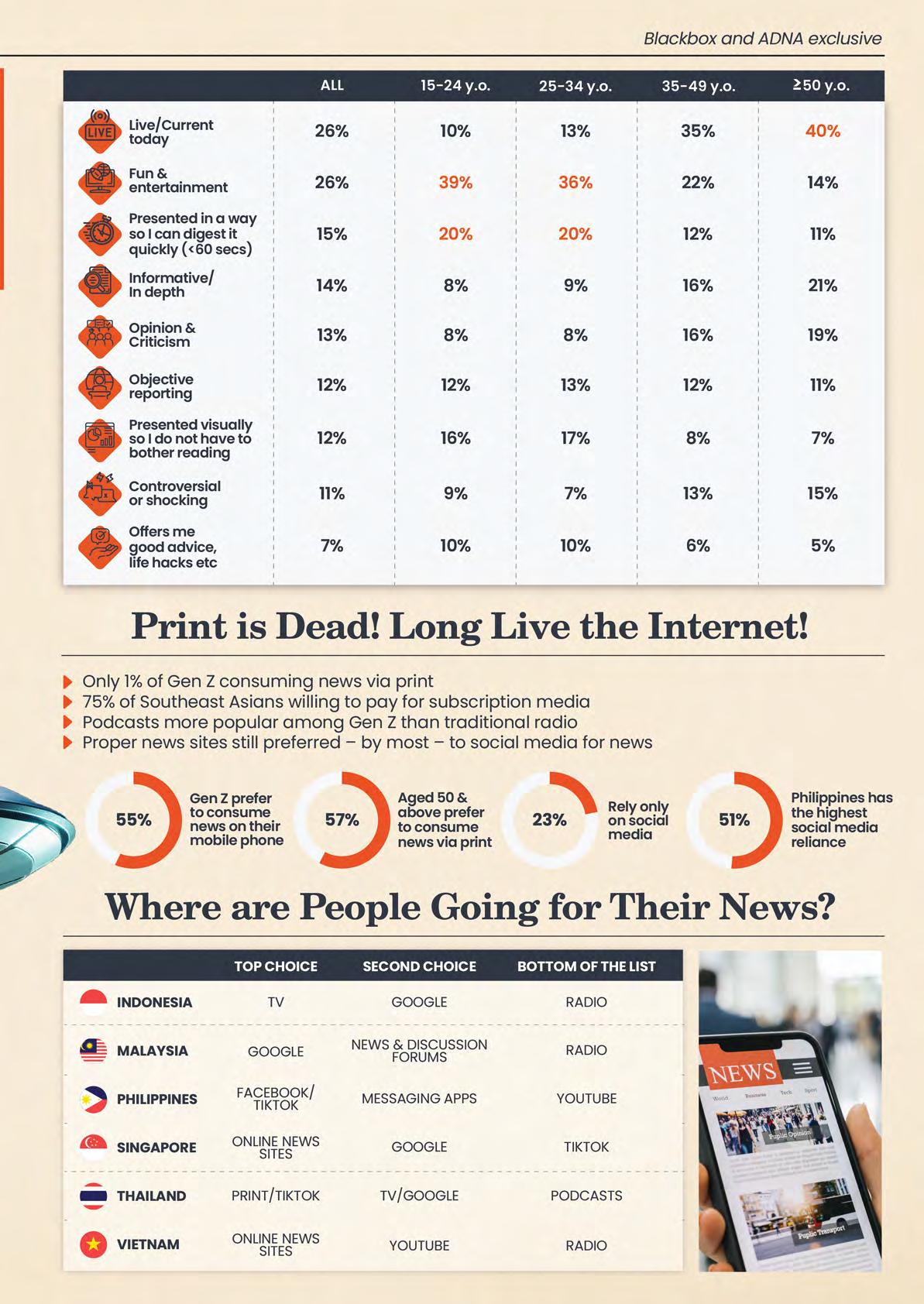Views on the News: Decoded

Aug/Sep 2023
An Insights Report by Blackbox Research
A CROSS-SECTIONAL ANALYSIS OF NEWS
ATTITUDES AND BEHAVIOUR IN SOUTHEAST ASIA B B O X C K L A
CONSUMPTION
B B O X C K L A
© 2023 Blackbox Research Pte Ltd
All rights reserved.
No part of this publication may be reproduced, stored in a retrieval system, or transmitted in any form or by any means, electronic, mechanical, photocopying, recording, or otherwise, without the prior written permission of Blackbox Research.
https://blackbox.com.sg
This insights report was made possible by data and intelligence from ADNA (Audience DNA). ADNA is a Creative Intelligence consultancy built upon a proprietary quantitative research platform that incorporates real-time audience feedback into business strategising and creative thinking processes, so you can make braver decisions with more confidence.
https://adna.global

CONTENTS 04 06 08 12 Breaking News: Visualising Southeast Asian Views on the News Demise of Traditional Media? Not All is Lost 07 10 05 14 Introduction “Entertain Me!”, say Southeast Asians Conclusion: Audience Understanding Key in a Dynamic News Environment The Recipe for News Views Southeast Asians: “Fake News? We Can Live with It” When and How do Southeast Asians Consume News?
Introduction
We live in a time of unprecedented access and exposure to news. The rapid acceleration of digitalisation and our ever-increasing reliance on digital devices has connected us to the goings-on of the world like never before, making it commonplace to hear about an event on the other side of the world within seconds of it happening. This instant connection with real-time events is delivered through an endless plethora of apps, websites, and social media networks, before we even mention the traditional channels of news delivery - television, radio, and newspapers.
All of which makes the positioning question of this study - “How do Southeast Asians like to consume news today?” - a deceptively challenging one to unravel. Long gone are the days when we took in our news from our favourite newspaper in the morning and chose from only several possible options to catch up with the nightly TV news. Even if those preferences still hold true for some (and they do), the fact is that we all now consume news amorphously, through multiple channels and modalities. Often, the very decision-making of what to read or watch next is taken out of our own hands, with mysterious and powerful algorithms steering us to the news we “want” to see next.
With a media landscape as complex and dynamic as this, it has become ever-more important for stakeholders within the news domain - such as leaders of news organisations, editors, journalists, content strategists and advertisers, among othersto get a grasp on the habits, preferences and expectations of their audiences. For media players based in Southeast Asia, in particular, a melting pot of different languages, cultures, and political environments, we hope the rich insights we have uncovered into how these diverse audiences consume news prove valuable.
#ASEANScan Insights
The primary research for this report stems from a comprehensive ASEAN-wide survey by Blackbox and Audience-DNA (ADNA), conducted in July-August 2023. We gathered insights from more than 9,000 respondents in six countries –Singapore, Malaysia, Thailand, Vietnam, Indonesia, and the Philippines.
Hold the Front Page: Framing Our Insights
Given how overwhelming news coverage is today - and how complex and diverse the means of delivery - we designed our study to target insights in five core areas, with comparative demographic and countryby-country analysis underpinning the analysis.
We were most interested to find out:
• How do Southeast Asians prefer their news?
I.e. What are the ingredients to make news coverage attractive to different respondent personas?
• When do Southeast Asians consume news?
• Where do Southeast Asians go to find news?
• What devices and formats are Southeast Asians using to consume their news?
• Whether fake news and misinformation is a big concern to Southeast Asians or not.
4
“Entertain Me!”, say Southeast Asians
Of course, “news” is a broad term, with many possible categories of content coming under this umbrella. To begin with, our study sought to get a grasp on what the most popular categories of news are among Southeast Asians.
When asked for their preference of news types, our respondents preferred “Soft News” (42% of responses) over “Hard News (38%) and “Commentary and Opinion” (20%). At a country level, the sentiments of all countries were broadly aligned, with the exception of the more serious-minded Singaporeans, where 54% expressed a preference for hard news.
Augmenting this finding is the result of our query into what types of news Southeast Asians are prone to click on first each day. “Entertainment and Celebrity News” came out on top here, with almost one in three Southeast Asians (30%) selecting it from a list of 12 options. With “Sports” (25%) and “Food and Restaurants” (24%) emerging as the second and third most popular options, this collective response is demonstrative of a general preference among Southeast Asians for specialist news categories on the lighter side of the spectrum.
Mind the Generational Gap
Exploring the cross-section of demographic data gives us some interesting findings in this area. On the soft news vs hard news question, there is a very clear generational gap. Fewer than one in five of both Millennials (17%) and Gen Zs (13%) are drawn to hard news, which is in stark contrast with the more than half of Gen Xers (52%) and Baby Boomers (59%) who prefer this kind of news.
Similarly, entertainment and celebrity news earns the first click of half of Gen Z (52%) and
Millennials (47%) - more than double that of the older cohorts in the sample.
These findings appear to confirm common impressions that younger audiences tend to gravitate towards news content that is easier and quicker to digest, with a marked predilection to celebrity and entertainment news, possibly a byproduct of an “Instagram effect” and the continued laser focus on young consumers from entertainment purveyors and their targeting algorithms.
The older generations, by contrast, still look for the “serious” sections of their newspaper or website more often, which in part can be attributed to simply getting older - economic news, for example, tends to interest those old enough to have mortgages and school fees to pay - but it is also likely that these preferences were in part instilled in their youth, when traditional news options had much less competition and such ready digital access to the variety of today’s options was not possible. It will be fascinating to see in years to come if the tastes of digital natives swerve closer to those of the older generations, or if the impact of digitalisation has already coloured their news tastes differently for life. Either way, media moguls, news editors, and content strategists will need to keep a keen eye on the evolving preferences of their audiences when designing their publications and programming.
5
Fewer than one in five of both Millennials & Gen Zs are drawn to hard news, in stark contrast to the more than half of Gen Xers & Baby Boomers who prefer this kind of news.
The Recipe for News Views
Beyond news category preferences, we also wanted to dig deeper to find out what components and features of news content attracted viewers and readers most. Asked to choose from a range of elements that draws them in to news stories, “fun and entertainment” and “live/current today” were selected by one in four Southeast Asians (26% each). Beneath this overarching trend lie diverse national proclivities. Notably, Singaporeans display the strongest affinity for current affairs, with 42% of respondents choosing this option, while entertaining elements are most important to Thais (37%).
The responses to this question also belied the influence of generational disparities in news tastes. Among the youngest age bracket, aged 15-24, two in five (39%) indicated a preference for “fun and entertaining” news, a sentiment closely mirrored by 25-34-year-olds (36%). However, as age advances, a discernible shift

emerges. Respondents aged 35-49 exhibited a clear preference for “live and current” news, with a considerable 35% resonating with this category. This was even more pronounced for those aged 50 and above, with two in five (40%) favouring current affairs over all other news categories.
Interestingly, our findings showed that a notable 15% of Southeast Asian respondents held a penchant for news stories that could be swiftly consumed within the span of 60 seconds. This preference varied across the region, with Thais (25%) most in favour of this micro-form news content.
When delving into specific demographic considerations, among the younger audience aged 15-34, this craving for swift digestibility surfaced as the second-most desirable trait, with one in five (20%) of respondents aligning with this preference.
6
Southeast
Asians: “Fake
We Can Live with It”
We live in an era where the proliferation of misinformation, especially online, is rampant. Yet, according to the data we uncovered from our study, Southeast Asians are not as concerned by “Fake News” as perhaps people are elsewhere in the world.

When asked “How much of the news that you consume do you think is fake?”, only 14% of Southeast Asians told us that they think more than a quarter of what they read and watch is untrue. Additionally, 5% think there is no fake news at all(!), while the vast majority (81%) think up to 25% of all news they read is fake.
In terms of age profiles, those aged 50 and above are the most trusting - one in five (19%) regarding all news as true. Compare this with all of those under 49, where we couldn’t find a single respondent who thought all news was totally trustworthy, and it tells a story that those who have grown up with the internet understand its pitfalls better than the senior generation.
Nationally, Thailand is the most trusting country in Southeast Asia; more than nine in 10 Thais (92%) believe that the fake news ration is less than 25%.
News?
Taken together, this data appears to suggest that most Southeast Asians have a healthy perspective on fake news - they understand that it is there but are not unduly panicking over it. “We can deal with it” comes the message.
The concerning aspect is among seniors, where a persistent faith in news is present. Little wonder that this age profile continues to prove the most vulnerable to online scams and persuasive misinformation that skews choices in matters as important as national elections and referendums. Southeast Asian governments will do well to continue with education campaigns targeted at seniors to help mitigate this blind spot, especially as the rise of AI threatens to make this an even more pernicious problem than it already is.
7
One in five of those aged 50+ in Southeast Asia believe there is zero fake news.


When and How do Southeast Asians Consume News?

Understanding the tastes of their audiences is one thing, but it is equally important for platforms distributing news content to understand when their audience first begins consuming content each day, and what device they tend to use when doing so. The interwined relationship between these dynamics provides powerful insights to aid them in planning their distribution and digital marketing models.
Breaking News? It Can Wait Until Tonight
Across all of Southeast Asia, we found that one in three (33%) are early birds - consuming news before 9am - while almost exactly the same proportion wait until after 6pm (32%). It stands to reason that the most popular news consumption timings bookend daytime working and school hours, but it was notable to find that so many wait until evening time before catching up with goings on in the world. Between countries, the clearest outlier here is the Philippines, where more than half (52%) don’t look at the news until after 6pm.
Generationally, once again it is the Gen Zs who buck the trend most decisively. While at least two in five of all those aged 25 and above consume news before 9am, fewer than one in 10 of Gen Zs do (8%), with the evening hours being by far the most preferred time for youngsters (55%).
“Print? What’s That?”: Gens Y and Z
The “death of print media” has long been foretold and the reading isn’t pretty when we look at the preferred medium Southeast Asians prefer to use to consume their news. Overall, fewer than one in five (18%) prefer print, but this number is held up almost single-handedly by those aged 50 and above (57%). The responses make for horror reading among the other age demographics: 15-24 year olds (1%); 25-34 (0%!); and 35-49 (7%). If the importance of digitalising content output for younger audiences wasn’t obvious already, data like this provides another slap to the face to print that probably isn’t needed.
10
Engaging Young Audiences Digitally: The View from Europe
Various research studies on news consumption trends in Europe indicate that the younger demographics can be effectively reached through the utilization of social media platforms. A qualitative study conducted in Austria unveiled that individuals between the ages of 18 and 25 primarily engage with news content available exclusively on digital platforms such as social media, news portals, WhatsApp, and various other applications. Furthermore, a significant number of participants conveyed that news tends to come across their attention organically rather than actively seeking it out themselves. Regarding the utilization of social media, individuals aged 16 to 19 in Sweden employ their social media feeds as a means to access news updates and remain informed about current events.
Source: https://journals.sagepub.com/doi/10.1177/14648849221123385?icid=int.sj-abstract.citing-articles.1#:~:text=Social%20 media%20and%20apps%20dominate,become%20more%20and%20more%20irrelevant
It is unsurprising to find that computers (34%) and smartphones (33%) are the clear winners in the preferred device stakes, while TV is holding its relevance (22%) better than radio (6%). At the country level, there were no shocking outliers here, although we do discern that the digital vs print divide is most acute in Malaysia and the Philippines, where smartphones pulp newspapers even more convincingly than the overall sample.
Choosing From a Buffet of Content Platforms
We delved deeper into the question of how Southeast Asians prefer to consume their news content by asking, “Which of the following presents news and information in a way that best suits you?” Respondents were allowed to select as many options from a long list as they wished, and the results demonstrate that regardless of age or nationality, today we all imbibe our news content from a variety of sources and angles (see right). It was notable to us, however, that more mature channels for news, such as Google, online news sites, and television, still hold sway over the likes of TikTok and YouTube, even among Millennials and Gen Zs.
11
Online news sites 28% 18% 12% 24% 14% 5% 24% 15% 9% 19% 13% 14% 5% Google Print newspaper & magazines Youtube Tiktok Podcasts Television Messaging apps News & discussion forums Facebook Instagram Linkedin Radio
Demise of Traditional Media?
Not All Is Lost
While we see that many news consumption tastes and habits are driven by digitalisation, with a clear preference for content to be online, instantly accessible, and delivered via a digital device, this does not necessarily equate to the demise of “traditional” journalism. Rather, our study found that there remains demand in Southeast Asia for high-quality news content across all nationalities and age demographics.
Social Media Not Yet Trusted for News in SE Asia (Mostly)
There is a common perception that part of the struggles of “Big Media” in maintaining and growing page views is due to an exodus of the young generations, who pick up all their news almost exclusively from social media platforms. While there is research supporting this view in the West, this did not hold true for our Southeast Asian sample.
We asked our respondents if they agreed or disagreed with the statement “I much prefer to pick up my news via social media than having to bother going to news sites”; almost four in five Southeast Asians either somewhat or strongly disagreed. Singapore is the most social media-cynical country, where 94% disagreed. In the Philippines on the other hand, more than half of respondents agreed that they need only social media to pick up their news.
Interestingly, while many may have expected the sentiment of the young to veer towards social media for news intake, this was not the case. The responses from 15-24 and 25-34 year olds matched practically exactly with the overall response, with four in five disagreeing that social media trumps news sites for news. One takeaway from this data may be that social media is being used more as a prompt for news, rather than as a direct news provider in its own right.
Youth Lead Way in Climbing Content Paywalls
A World Economic Forum study of over 9,000 respondents across China, Germany, India, South Korea, the UK, and the US reveals that although the majority spends about 24 hours weekly on news and entertainment, less than half pay for it. Young individuals (aged 16-34) are more inclined to pay for content, with an average of 61% currently paying for entertainment and 17% for news – figures that are in both cases above the global averages in the general population. The synthesized results of this study demonstrate that while the current proportion of individuals paying for content may be modest, there is a growing inclination towards future payment. Globally, the willingness to pay in the future stands at 53% for news and 70% for entertainment.
Source: https://www.weforum.org/press/2020/04/ less-than-half-pay-for-media-news-and-entertainment-but-willingness-to-pay-is-rising-study-finds/
Southeast Asians Willing to Pay to Bypass Paywalls
Content paywalls are now commonplace in the digital content ecosystem, a tactic of enticing readers to subscribe to access “premium” content. International outlets such as the New York Times, the Wall Street Journal, the Daily Telegraph, Bloomberg, and Singapore’s Straits Times all require some form of paid subsciption to access their news content. When first introduced, paywalls were universally derided by audiences used to free access to everything online, but our study now suggests that a tipping point has been reached in Southeast Asia.
12
Hearteningly, we found that three in four Southeast Asians disagreed with the statement that there was “no point in paying for news services as I can get it all for free from social media”. Further to this, three in five (64%) said they would be happy to pay for specialised news and information aligned with their personal interests, such as sport, technology, financial advice, etc.
At the country level, Singaporeans are most willing to subscribe to content, with four in five saying they would do so. The Vietnamese, on the other hand, seem to value specialised news content least; only one in four (26%) state that they are willing to pay.
With all eyes on the younger generations for future income, news publishers will be pleased to note that three in five of both Millennial and Gen Z Southeast Asians indicate a willingness to pay for content they are interested in.
Collectively, these insights provide reassurance to news producers that audiences of all ages do still place value on quality news content and information and are willing to pay for it - so long as it is carefully curated to their personal interests.

13
More than three in five Southeast Asians are willing to pay to subscribe to specialised news and information so long as it aligns with their personal interests (e.g. sport, finance, tech news, etc).
Conclusion: Audience Understanding Key in a Dynamic News Environment
The digital revolution has undeniably transformed the way news is consumed around the world. It is not surprising to discover from our study that immediate access to news is expected as a given, and a preference to engage with the content online via a digital device is practically universal.
Indeed, we are long past the point of describing today’s digital landscape of news and content as “new” - this has been the state of play for at least a decade now and our study has shown that attitudes have begun to mould in line with that, as seen in the diminishing resistance to subscription paywalls. Backing up this encouraging observation for news organisations will be that there remains a high level of discernment among Southeast Asians at all age levels when it comes to judging the credibility and quality of news sources. Young Southeast Asians may spend an awful lot of time on social media platforms, but it appears that most don’t do so to search for news.
Related to this, fake news, while a pressing concern everywhere, does not seem to alarm Southeast Asians a great deal, with our data hinting that this isn’t because they don’t think it exists, but simply that the levels of awareness and acceptance seem to be reasonably high.
The tastes of Southeast Asians in news preferences are understandably diverse, but across several questions we saw that entertainment was both a favoured category and component of news coverage, especially among Millennials and Gen Z. How long, we wonder, until “soft news” starts working its way to the front pages of websites and newspapers to reflect this changing taste?
The findings of our study illustrated to us that the inquiry of “Where do Southeast Asians go to find news?” demands further avenues of study beyond the scope of our report. It may well be a moot point - with every connected user confronted by news from a plethora of angles every second they hold their smartphone, perhaps we should think not in terms of how and where a user finds content, but how the content finds them. Deep research that tracked the user journeys of different audience types would throw up fascinating results.
In the meantime, what is clear is that the news landscape in Southeast Asia - a region of diverse cultures, languages and sociopolitical environments - is a richly dynamic one. Manifold varied tastes in news in the region may present a devilish challenge for news organisations, but by investing in developing a holistic understanding of their different audience types, they can create agile and relevant content strategies that speak to a wide cross-section of Southeast Asians, young to old, via an array of channels and formats that best suit them.
14
With every connected user confronted by news from a plethora of angles every second they hold their smartphone, perhaps we should think not in terms of how and where a user finds content, but how the content finds them.

15 Liked this? Check out our other articles on the news consumption trends, habits and preferences of Southeast Asia: https://bit.ly/whatdrivesfirstclick https://bit.ly/from-print-to-pixels https://bit.ly/news-flavour
Make Decisions that Matter.
Blackbox is Southeast Asia’s leading decision intelligence provider, delivering decision science solutions and community-wide perspectives on contemporary problems and challenges. As a sophisticated provider of data insights, we work closely with businesses, governments, regulators, and non-profit organisations. Reach out to our team to find out how we can help your organisation.

connect@blackbox.com.sg
https://blackbox.com.sg
@Blackbox










